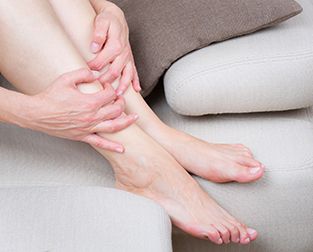Restless legs syndrome (RLS)/ Willis-Ekbom disease (WED)
RLS is a disorder of neurological origin, which manifests as uncomfortable sensations in the extremities (mainly the legs) at rest, for example when sitting or lying down. These sensations cause the need to stand up, walk, and move. With movement, the unpleasant sensations are relieved or disappear.
The disorder appears in 2-3% of the population with some severity and affects both men and women. It can begin at any age, most frequently starting after the fourth decade of life.

RLS tends to affect quality of sleep, causing drowsiness during the day, as well as anxiety and depression that significantly impact the quality of life of those affected.
How is RLS diagnosed?
Signs and symptoms of the disease
The terms used by patients to describe RLS symptoms include: “unease”, “tingling”, “cramps”, “pricking”, “nervousness”, “pain”, “deep strange sensations”, “burning”, “crazy legs”, etc. The main characteristics are:
- Irresistible need to move the legs (or arms), which may or may not be accompanied by uncomfortable sensations
- Onset or worsening of symptoms during periods of inactivity, such as sitting or lying down in bed, in the cinema, or during long trips (for example, in the car or on a plane)
- Relief with movement: the discomfort is alleviated or disappears when subjects with RLS move, walk, or rub their legs. This urgent need to move is what gives the name to the disorder.
- Worsening of symptoms late in the evening or at night: this feature makes it difficult for patients to fall asleep or stay asleep. During the day the discomfort disappears or exists, but with less intensity.
Clinical diagnosis
Diagnosis should also take into account the existence of family members with the same disorder (familiar predisposition exists), history of response to dopaminergic pharmaceuticals (treatment used for the disease), and the presence of periodic leg movements during sleep and sometimes during wakefulness (appears in more than 80% of patients).
The evolution of RLS tends to be chronic and slowly progressive (increasing in intensity with time), altering sleep in the majority of subjects. Physical examination and routine medical tests tend to be normal.
In approximately 20% of cases, there are other medical situations that explain the emergence of symptoms of RLS: anemia, kidney failure, polyneuropathy, pregnancy, pharmaceuticals, etc.
RLS can sometimes be diagnosed in a consultation with a doctor by conducting a clinical history of the patient. This means that the diagnosis is clinical. However, along with the clinical history, some tests may be very useful:
- A blood test which includes levels of iron and ferritin (this last parameter is abnormal in many patients).
- Studies in the sleep laboratory (nocturnal polysomnography and simple or multiple suggested immobilization test): these are performed to determine if there are periodic movements in the legs (or arms) and to assess the quality of sleep in patients suffering from RLS.
- Electromyography and nerve conduction studies: these serve to rule out lesions at the roots and peripheral nerves of the extremities.
What is the cause of restless leg syndrome?
Most research findings suggest a disorder in the functioning of dopamine, a substance present in the nervous system that is responsible for the regulation of movement. Dopamine needs iron to function properly, and a malfunction of iron and/or decreases of deposits (ferritin levels) have been noted in patients suffering from RLS. Very often, there are close family members that are affected.
Does restless legs syndrome require treatment?
The following measures should be taken into account:
Non-pharmacological measures
- It is important to maintain a regular sleep schedule, exercise moderately (late in the evening), and reduce the consumption of coffee, tobacco and alcohol (these are known to worsen RLS discomfort).
- It is also important to avoid certain medications that may worsen symptoms (antihistamines, some sedatives that block dopamine and certain antidepressants).
- If possible causes of RLS are identified, the first step is to try to correct them (iron deficit, antidepressant drugs, and some dopamine blockers, abnormalities in kidney function, etc.).
Pharmacological measures
-
In the vast majority of cases, it must be kept in mind that RLS is a chronic and progressive disorder. At the beginning, it manifests itself sporadically, with discreet discomfort that does not interfere significantly with the life of the subjects who suffer from it. However, with time, the intensity of symptoms is greater and more frequent, and it is not uncommon for these patients to experience major problems falling asleep and staying asleep, showing great restlessness, nervousness and unease, above all in situations requiring prolonged rest. The consequences are very negative for the well-being of the patient, so in these cases pharmacological treatment should be considered.The most commonly used treatments are:
- Dopaminergic agonists: These are the first-line drugs. They are used to treat Parkinson’s disease, and at lower doses, also RLS. The main ones include: pramipexole, ropinirole, rotigotine, and levodopa.
-
Antiepileptic: these drugs are used to treat epilepsy and neuropathic pain, and have also been found to be useful in the treatment of RLS. The main ones are: gabapentin and pregabalin.
-
Opioids: in some cases codeine or extended-release oxycodone/naloxone can be indicated.
What should I do if I suspect I have restless leg syndrome?
It is recommended in all cases to go to a specialized sleep center to be evaluated correctly. The doctor will determine the intensity of the symptoms that you have, and will evaluate the possibility of a treatment to control your disease.
Links of interest:
Spanish Association of Restless Legs Syndrome